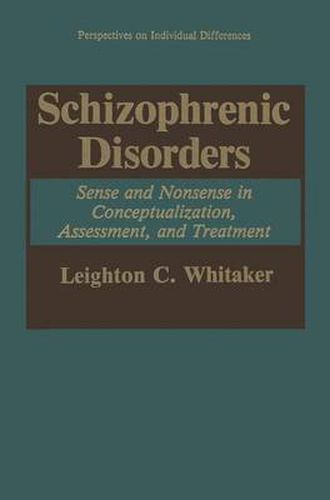Readings Newsletter
Become a Readings Member to make your shopping experience even easier.
Sign in or sign up for free!
You’re not far away from qualifying for FREE standard shipping within Australia
You’ve qualified for FREE standard shipping within Australia
The cart is loading…






This title is printed to order. This book may have been self-published. If so, we cannot guarantee the quality of the content. In the main most books will have gone through the editing process however some may not. We therefore suggest that you be aware of this before ordering this book. If in doubt check either the author or publisher’s details as we are unable to accept any returns unless they are faulty. Please contact us if you have any questions.
No diagnosis of mental disorder is more important or more disputable than that of schizophrenia. The 1982 case of John Hinckley, who shot President Reagan, brought both aspects of this diagnostic dilemma to the forefront of national attention. It became evident to the general public that the experts engaged to study him exhaustively could not agree on whether Hinckley was schizophrenic. General public outrage ensued, as schizophrenia, the sacred symbol of psychiatry, in the words of Thomas Szasz (1976), emerged as a king of Alice in Wonderland travesty. Schizo phrenia seemed not to be a legitimate diagnostic entity but some sort of facade erected to protect the guilty. In 1973, David Rosenhan had already shown the readers of Science that schizo phrenia was a label that could be given to normal people presenting with a supposed auditory hallucination on even one occasion. In Rosenhan’s studies, mental health professionals were outclassed by the regular psychiatric hospital patients, who cor rectly saw the false schizophrenics as imposters while the professional diagnosticians continued to fool themselves.
$9.00 standard shipping within Australia
FREE standard shipping within Australia for orders over $100.00
Express & International shipping calculated at checkout
This title is printed to order. This book may have been self-published. If so, we cannot guarantee the quality of the content. In the main most books will have gone through the editing process however some may not. We therefore suggest that you be aware of this before ordering this book. If in doubt check either the author or publisher’s details as we are unable to accept any returns unless they are faulty. Please contact us if you have any questions.
No diagnosis of mental disorder is more important or more disputable than that of schizophrenia. The 1982 case of John Hinckley, who shot President Reagan, brought both aspects of this diagnostic dilemma to the forefront of national attention. It became evident to the general public that the experts engaged to study him exhaustively could not agree on whether Hinckley was schizophrenic. General public outrage ensued, as schizophrenia, the sacred symbol of psychiatry, in the words of Thomas Szasz (1976), emerged as a king of Alice in Wonderland travesty. Schizo phrenia seemed not to be a legitimate diagnostic entity but some sort of facade erected to protect the guilty. In 1973, David Rosenhan had already shown the readers of Science that schizo phrenia was a label that could be given to normal people presenting with a supposed auditory hallucination on even one occasion. In Rosenhan’s studies, mental health professionals were outclassed by the regular psychiatric hospital patients, who cor rectly saw the false schizophrenics as imposters while the professional diagnosticians continued to fool themselves.